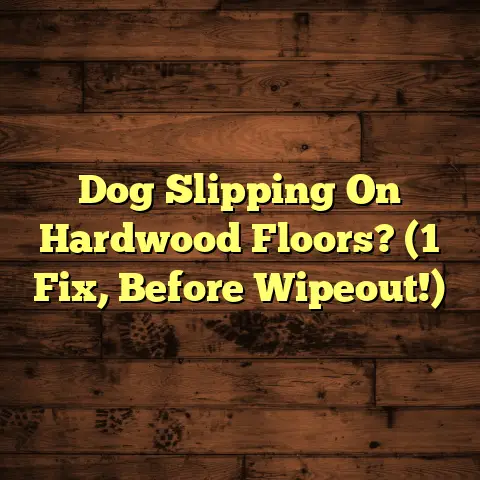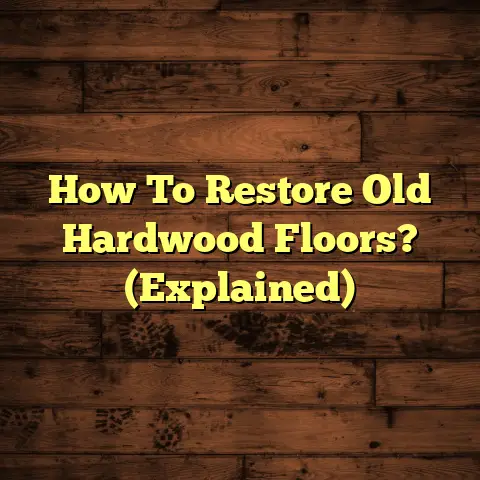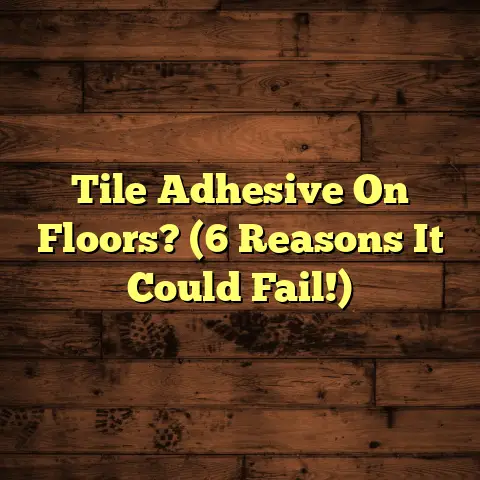Replace a Single Laminate Board? (1 Trick Installers Use!)
Ever had that sinking feeling?
You know, the one where you spot a scratch, dent, or even worse, water damage on a single laminate board?
Right in the middle of your otherwise perfectly pristine floor?
It’s like a tiny imperfection that screams for attention, isn’t it?
That one flawed board can totally throw off the vibe of the whole room.
It makes it feel less inviting, less… well, less perfect.
I get it. I’ve been there.
As a flooring contractor for over 15 years, I’ve seen it all.
And trust me, you’re not alone.
But before you start panicking about replacing the entire floor, let me share a little secret.
The Installer’s Secret Weapon:
Targeted Laminate Board Replacement
There’s a trick that flooring installers like myself use all the time to replace a single laminate board without tearing up the whole floor.
It’s all about understanding the “floating floor” system.
Laminate floors aren’t usually glued
down.
Instead, they “float” above the
subfloor, interlocking together like
a giant jigsaw puzzle.
This clever design allows us to replace individual boards without disturbing the rest of the floor.
The magic trick?
It involves a little bit of heat, a tapping block, and some finesse.
We use a heat gun to gently soften the adhesive (if any) holding the damaged board in place.
Then, with the help of a tapping block and sometimes a pry bar, we carefully coax the damaged board out of its interlocking embrace.
Here’s a quick rundown of the process:
- Heat it up: Use a heat gun to soften any adhesive.
- Tap, tap, tap: Employ a tapping block to gently loosen the board.
- Pry with care: Use a pry bar if needed, but be super gentle!
- Slide and secure: Slide the new board into place and lock it in.
Safety First!
Always wear safety goggles and gloves when working with power tools and adhesives.
Now, let’s dive deeper into the world of laminate flooring so you can understand exactly why this trick works and how to do it right.
Section 1: Understanding Laminate Flooring
So, what exactly is laminate flooring, anyway?
It’s not solid wood, that’s for sure.
Think of it as a multi-layered sandwich, each layer playing a crucial role in its durability and appearance.
The Laminate Layers:
Wear Layer: This is the top layer, the one you walk on.
It’s a clear, protective coating that resists scratches, stains, and fading.It’s usually made of aluminum oxide.
-
Design Layer: This layer is a high-resolution photographic image that mimics the look of real wood, stone, or tile.
Thanks to advancements in printing technology, these designs can be incredibly realistic.
Core Layer: This is the heart of the laminate board.
It’s usually made of high-density fiberboard (HDF) or medium-density fiberboard (MDF).This layer provides stability, durability, and resistance to indentations.
-
Backing Layer: This is the bottom layer, designed to protect the core from moisture and provide additional stability.
Why Choose Laminate?
Laminate flooring has become incredibly popular over the years, and for good reason.
Here’s why homeowners love it:
-
Affordability: Laminate is significantly cheaper than hardwood, stone, or tile.
According to HomeAdvisor, laminate flooring installation costs range from \$4 to \$11 per square foot, compared to hardwood’s \$8 to \$25 per square foot.
Source: HomeAdvisor
-
Easy Installation: The “floating floor” design makes laminate relatively easy to install, even for DIYers.
-
Versatility: Laminate comes in a wide range of styles, colors, and textures, so you can find the perfect match for your décor.
-
Durability: While not as durable as hardwood, laminate is still resistant to scratches, stains, and fading, making it a good choice for high-traffic areas.
Why Does Laminate Get Damaged?
Even with its protective layers, laminate isn’t invincible.
Here are some common causes of damage:
-
Heavy Furniture: Dropping heavy objects or dragging furniture across the floor can cause dents and scratches.
-
Pets: Pet claws can scratch the wear layer, and accidents can cause stains and warping if not cleaned up quickly.
-
Humidity: Excessive moisture can cause the core layer to swell and warp, especially if the laminate wasn’t properly installed or sealed.
-
Improper Installation: Gaps between boards or uneven subfloors can put stress on the laminate, leading to cracks and breaks.
Section 2: Assessing the Damage
Okay, so you’ve got a damaged laminate board.
Before you start tearing things up, let’s take a closer look at the damage and figure out if replacement is really necessary.
Signs You Need to Replace a Board:
-
Visible Scratches: Minor scratches can often be buffed out with a scratch repair kit, but deep scratches that penetrate the wear layer may require replacement.
-
Deep Dents: Dents that compress the core layer are usually irreparable and require board replacement.
-
Warping Due to Moisture: If the board is visibly warped or swollen, it’s likely due to moisture damage and needs to be replaced to prevent further issues.
Superficial vs. Deep Damage:
Run your hand over the damaged area.
Does it feel smooth, or can you feel a distinct indentation or roughness?
If it’s smooth, the damage may be superficial and repairable.
If you can feel a significant difference in texture, the damage likely extends to the core layer and requires replacement.
Identifying the Laminate Type:
This is crucial!
You need to know the exact brand, style, and color of your laminate flooring to ensure a perfect match when you replace the board.
Check your original flooring packaging, receipts, or any leftover boards you might have stored away.
If you can’t find the information, take a sample of the damaged board to a local flooring store.
They can usually help you identify the type of laminate and find a matching replacement.
Section 3: Tools and Materials Needed
Alright, you’ve assessed the damage, identified your laminate type, and decided to replace the board.
Now it’s time to gather your tools and materials.
Here’s what you’ll need:
-
Replacement Laminate Board: Make sure it’s an exact match to your existing flooring.
-
Heat Gun: This is essential for softening any adhesive holding the damaged board in place.
A standard heat gun with adjustable temperature settings will do the trick.
-
Tapping Block: This is a small, rectangular block made of wood or plastic.
It’s used to gently tap the laminate boards into place without damaging the edges.
-
Pry Bar: A small, flat pry bar can be helpful for lifting the damaged board, but use it with extreme caution to avoid damaging adjacent boards.
-
Utility Knife: This is useful for scoring the edges of the damaged board to help loosen it.
-
Measuring Tape: You’ll need this to measure the damaged area and ensure the replacement board fits perfectly.
-
Safety Goggles: Always protect your eyes from debris and flying particles.
Where to Buy:
You can find most of these items at your local hardware store or home improvement center.
Replacement laminate boards can be purchased from flooring stores or online retailers.
Household Alternatives:
If you don’t have a tapping block, you can use a small piece of wood wrapped in a soft cloth.
Just make sure it’s smooth and won’t scratch the laminate.
In a pinch, a flathead screwdriver can be used as a pry bar, but be extra careful not to damage the surrounding boards.
Section 4: Step-by-Step Replacement Process
Okay, here’s where the rubber meets the road.
I’m going to walk you through the entire replacement process, step-by- step, so you can confidently tackle this project.
1. Preparation:
-
Clear the Area: Remove all furniture, rugs, and any other obstacles from the area around the damaged board.
You need plenty of space to work.
-
Gather Your Tools: Make sure you have all the necessary tools and materials within easy reach.
There’s nothing worse than having to stop mid-project to hunt down a missing tool.
2. Heat Application:
-
Position the Heat Gun: Hold the heat gun a few inches above the damaged board, focusing on the edges.
-
Apply Heat Carefully: Move the heat gun back and forth in a slow, even motion.
Don’t hold it in one spot for too long, as this can damage the laminate.
-
Test the Adhesive: After a few minutes of heating, try gently lifting the edge of the board with the utility knife.
If it feels loose, you’re on the right track.
If it’s still stuck, apply more heat.
Important Tip:
Be patient!
Applying too much heat too quickly can damage the surrounding boards.
Take your time and gradually soften the adhesive.
3. Loosening the Damaged Board:
-
Score the Edges: Use the utility knife to carefully score the edges of the damaged board where it meets the adjacent boards.
This will help break the seal and make it easier to remove.
-
Position the Tapping Block: Place the tapping block against the edge of the damaged board.
-
Tap Gently: Use a hammer to gently tap the tapping block, working your way around the perimeter of the board.
The goal is to gradually loosen the board without damaging the surrounding boards.
-
Use the Pry Bar (If Needed): If the board is still stuck, carefully insert the pry bar between the damaged board and the subfloor.
Gently lift the board, working your way around the edges.
Be extremely careful not to damage the surrounding boards.
Pro Tip:
If the board is particularly stubborn, you can try using a suction cup to help lift it.
These are often used for lifting glass or tile and can provide a good grip on the laminate surface.
4. Installing the New Board:
-
Clean the Area: Before you install the new board, make sure the area is clean and free of any debris.
Vacuum or sweep the subfloor to remove any dust or dirt.
-
Position the New Board: Carefully align the new board with the surrounding boards.
Pay attention to the locking mechanisms.
Most laminate floors have a tongue- and-groove system that interlocks the boards together.
-
Engage the Locking Mechanism: Use the tapping block and hammer to gently tap the new board into place, ensuring that the locking mechanism is fully engaged.
You should hear a distinct “click” when the boards are properly connected.
-
Check the Alignment: Once the new board is in place, double-check the alignment with the surrounding boards.
Make sure there are no gaps or uneven edges.
Understanding Locking Mechanisms:
Laminate flooring uses various locking mechanisms to hold the boards together.
Some common types include:
-
Tongue-and-Groove: This is the most common type, where the tongue of one board fits into the groove of the adjacent board.
-
Click-Lock: This type uses a special locking system that allows the boards to “click” together without the need for glue or nails.
-
Fold-Down: This type requires you to fold the board into place and then lock it down.
5. Final Touches:
-
Secure the New Board: Once the new board is in place and the locking mechanism is engaged, give it a final tap with the tapping block to ensure it’s fully secured.
-
Clean the Area: Use a damp cloth to wipe away any dust or debris from the newly installed board.
-
Inspect the Installation: Take a step back and admire your work!
Make sure the new board blends seamlessly with the surrounding floor.
-
Maintain the Area: To prevent future damage, consider placing furniture pads under heavy objects and using rugs in high-traffic areas.
Troubleshooting Tips:
-
Board Won’t Lock: If the new board won’t lock into place, double- check the alignment and make sure there’s no debris blocking the locking mechanism.
-
Gaps Between Boards: If there are gaps between the new board and the surrounding boards, try using a pull bar to gently pull the boards together.
-
Uneven Edges: If the edges of the new board are uneven, you can try using a sanding block to smooth them out.
Conclusion
So, there you have it!
Replacing a single laminate board might seem daunting at first, but with the right tools, techniques, and a little bit of patience, it’s a perfectly manageable DIY project.
Remember that installer’s trick?
The heat gun and tapping block are your best friends in this endeavor.
By softening the adhesive and gently coaxing the damaged board out, you can avoid the hassle and expense of replacing the entire floor.
Don’t be afraid to tackle this project confidently.
You’ve got the knowledge and the skills to restore the beauty of your floor and make that pesky imperfection disappear.
And remember, if you ever feel overwhelmed or unsure, don’t hesitate to call a professional flooring contractor.
We’re always here to help!





